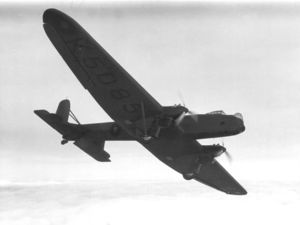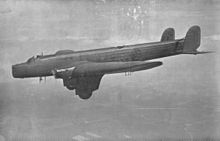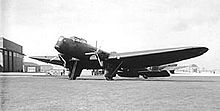Fairey Hendon Video - Picture

|
|
Fairey Hendon
Hendon

Picture - A Fairey Hendon flies over.
Role: Heavy night bomber
National origin: United Kingdom
Manufacturer: Fairey Aviation
First flight: 25 November 1930
Introduced: 1936
Retired: January 1939
Primary user: Royal Air Force
Produced: 1936-1937
Number built: 15
The Fairey Hendon was a British monoplane heavy bomber of the Royal Air Force designed by Fairey Aviation in the late 1920s, which served in small numbers with one Squadron of the RAF between 1936 and 1939. It was the first all-metal low-wing monoplane to enter service in the RAF.
Development
The Hendon was built to meet the Air Ministry Specification B.19/27 for a twin-engine night bomber to replace the Vickers Virginia, competing against the Handley Page Heyford and Vickers Type 150. The specification required a range of 920 mi (1,480 km) at a speed of 115 mph (185 km/h), with a bombload of 1,500 lb (680 kg). To meet this requirement, Fairey designed a low-winged cantilever monoplane with a fixed tailwheel undercarriage. The fuselage had a steel tube structure with fabric covering and housed the crew of five, consisting of a pilot, a radio operator/navigator, and three gunners, manning open nose, dorsal and tail positions. Bombs were carried in a bomb-bay in the centre-fuselage. Variants powered by either radial engines or liquid cooled V12 engines were proposed.

Picture - The prototype K1695 with two Rolls-Royce Kestrel 600 HP engines.
The prototype K1695 (which was known as the Fairey Night Bomber until 1934) first flew on 25 November 1930, and was powered by two 460 hp (340 kW) Bristol Jupiter VIII radial engines. The prototype crashed and was heavily damaged in March 1931, and so was re-built with two Rolls-Royce Kestrel engines replacing the Jupiters. After trials, 14 production examples, now named the Hendon Mk.II were ordered. These were built by Fairey's Stockport factory in late 1936 and early 1937 and flown from Manchester's Barton Aerodrome. Orders for a further 60 Hendons were canceled in 1936, as the prototype of the first of the next generation of British heavy bombers - the Armstrong Whitworth Whitley - had flown, and it showed much higher performance. The Hendon Mk.II was powered by two Rolls-Royce Kestrel VI engines. It had a fixed undercarriage and a crew of five while the production Hendon Mk.II included an enclosed cockpit for the pilot and navigator.
Operational history

Picture - A Fairey Hendon of no. 38 Squadron
In practice, the type was delayed by the crash and rebuild of the prototype, so the Heyford received the majority of the orders needed to replace the RAF's heavy bombers, the Hendon coming into service three years later. The single Hendon-equipped unit, No. 38 Squadron RAF, began operational service based at RAF Mildenhall in November 1936, replacing Heyfords, later moving to RAF Marham, Norfolk. Later, they went to No. 115 Squadron RAF, which was formed from No. 38 Squadron. The type was soon obsolete and replaced from late 1938 by the Vickers Wellington. By January 1939, the Hendons had all been retired and were then used for ground instruction work, including the radio school at RAF Cranwell.
Variants
Hendon Mk.I Prototype, one built. Hendon Mk.II Production variant with two Rolls-Royce Kestrel VI engines, 14 built
Operators
United Kingdom
Royal Air Force
No. 38 Squadron RAF
No. 115 Squadron RAF
Specifications (Hendon II)
Data from The British Bomber since 1914; Fairey Aircraft since 1915
General characteristics
Crew: 5
Length: 60 ft 9 in (18.52 m)
Wingspan: 101 ft 9 in (31.02 m)
Height: 18 ft 8 in (5.69 m)
Wing area: 1,146 ft² (106.5 m²)
Empty weight: 12,773 lb (5,806 kg)
Loaded weight: 20,000 lb (9,091 kg)
Powerplant: 2x— Rolls-Royce Kestrel VI inline piston V12 engine, 600 hp (447 kW) each
Performance
Maximum speed: 132 kn (152 mph, 245 km/h) at 15,000 ft
Cruise speed: 116 kn (133 mph, 214 km/h) at 15,000 ft
Range: 1,183 nmi (1,360 mi, 2,190 km)
Service ceiling: 21,400 ft (6,524 m)
Rate of climb: 940 ft/min (4.8 m/s)
Wing loading: 17.5 lb/ft² (85.4 kg/m²)
Power/mass: 0.06 hp/lb (0.099 kW/kg)
Climb to 6,500 ft: 9 minutes 12 seconds
Armament
Guns: 3x— .303 in (7.7 mm) Lewis guns in nose, dorsal and tail positions
Bombs: 1,660 lb (753 kg) bombs
Comparable aircraft
Handley Page Heyford
Tupolev TB-3
Related lists
List of aircraft of the Royal Air Force
Bibliography
Crosby, Francis. The World Encyclopedia of Fighters and Bombers. London: Lorenz Books, ISBN 0-75481-616-8.
Mason, Francis K. The British Bomber since 1914. London: Putnam Aeronautical Books, 1994. ISBN 0-85177-861-5.
Taylor, H.A. Fairey Aircraft since 1915. London, 1974: Putnam, ISBN 0-370-00065-X.
Thetford, Owen. Aircraft of the Royal Airforce, 1918-1957. London: Putnam & Company Ltd., 1957.
F.2 • N.4 • N.9 • N.10 • Hamble Baby • Campania • III • Pintail • Flycatcher • Fawn • Fremantle • Ferret • Fox • Kangourou • Firefly • Long-range Monoplane • Firefly II • Fleetwing • Hendon • Gordon • Seal • S.9/30 • TSR.1 • G.4/31 • Swordfish • Fantx´me • Battle • Seafox • P.4/34 • Albacore • Fulmar • Barracuda • Firefly (monoplane) • Spearfish • Gyrodyne • Primer • Gannet • Delta 1 • Jet Gyrodyne • Delta 2 • Ultra-light Helicopter • Rotodyne
Avions Fairey Junior • Avions Fairey Belfair • Tipsy Nipper
Fairey Hendon Pictures
More aircraft.
Source: WikiPedia